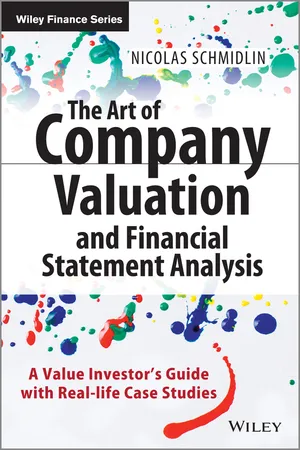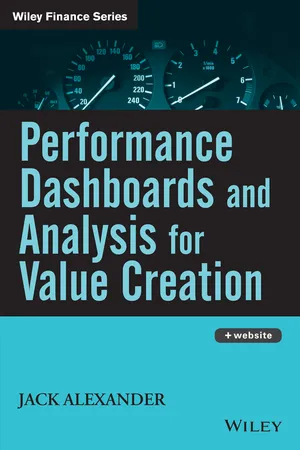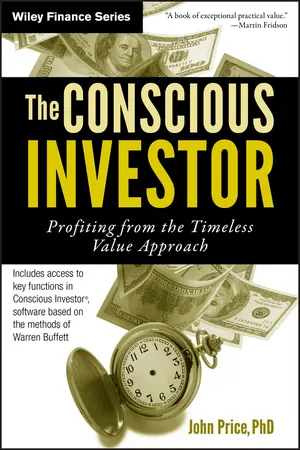Business
DCF Valuation
DCF valuation, or discounted cash flow valuation, is a method used to estimate the value of an investment based on its expected future cash flows. It involves discounting these cash flows back to their present value using a discount rate, which reflects the investment's risk. DCF valuation is widely used in finance and investment analysis to determine the intrinsic value of a business or asset.
Written by Perlego with AI-assistance
Related key terms
9 Key excerpts on "DCF Valuation"
- eBook - ePub
Corporate Valuation for Portfolio Investment
Analyzing Assets, Earnings, Cash Flow, Stock Price, Governance, and Special Situations
- Robert A. G. Monks, Alexandra Reed Lajoux(Authors)
- 2010(Publication Date)
- Bloomberg Press(Publisher)
Looking at current cash flow statements can prepare the investor to see what is happening with cash in a company. But there is no substitute for discounted cash flow analysis—looking into the future to predict how flows will be in the future.In its simplest form, the DCF process proceeds as follows:Step 1. Set aside the value of all assets—current and fixed—not used in the business to produce the estimated future earnings stream that is to be discounted.Step 2. Estimate future sales year by year over a preselected time horizon. (This is the period of time the investor intends to hold the investment until selling.)Step 3. Estimate the gross margins year by year, including depreciation expenses.Step 4. Estimate earnings before interest and taxes (EBIT) year by year.Step 5. Subtract interest and estimated taxes year by year.Step 6. Compute and subtract the average marginal incremental working capital costs required to put on each additional dollar of sales year by year. (Reverse the process for downsizing.)Step 7. Compute and subtract the average marginal incremental fixed capital costs of putting on each additional dollar of sales year by year (the reverse for asset sales).Step 8. Add back depreciation (the reverse for recaptures).Step 9. Compute the residual value of the company after the end of the horizon period by capitalizing last year’s projected earnings at the reciprocal of the selected discount rate.Step 10. Discount all values, including residual to present value, using a risk-adjusted cost of capital for the discount rate.10Step 11. Add back all set-aside values (step 1) for current and fixed assets not used to produce revenues. The total is the net present value (NPV) value of the business based on its anticipated future cash flows.11This is only one approach. A number of professors of finance have developed spreadsheets for calculating DCF.12Crystal Ball: Two Kinds of Questions
The most challenging aspect of doing discounted cash flow is, of course, the very fact of peering into the future. To predict how much net cash a company will be realizing in a future period requires understanding what a company does and how it does it. So there are two levels of inquiry: future strategy and future liquidity. Questions about strategy get at how the company will generate cash. Questions about liquidity get at how the company will manage it. - eBook - ePub
The Art of Company Valuation and Financial Statement Analysis
A Value Investor's Guide with Real-life Case Studies
- Nicolas Schmidlin(Author)
- 2014(Publication Date)
- Wiley(Publisher)
The value of companies can also be determined in different ways and is not given as one and the same figure for every investor. An aggressive private equity investor with an intention to liquidate the firm, for example, regards the book value, or more precisely the liquidation value, of a business as the true value. In contrast, a family business owner of the third generation will decline almost any purchase price offer, unless the buyer adopts the family philosophy. A business with M&A intentions, meanwhile, might pay a clear premium on the current market value of a target company, as long as the merger promises synergy effects or opens up new markets.As long as we participate in the stock exchange without any real say, however, just one figure counts: the future discounted cash flows. At the end of the 1930s, the American economist John Burr Williams coined the term of the intrinsic value of a business, based on its discounted cash flows. This approach is nowadays known as the discounted cash flow model (DCF model).The only objective company value is determined by the future free cash flow of a business, i.e. the amount that the owner could withdraw from the excess cash flow year after year without having a negative impact on the company. In order to take into account the prevailing level of interest rates and business risks, the expected future cash flows have to be discounted at a risk-adjusted interest rate. This results in the present value of the cash flows, which corresponds in sum to the intrinsic company value. In simple terms, the value of a business is measured by its expected cash flows, from which withdrawals could be made, across the entire lifetime of the enterprise.Whilst revenues, operating earnings and net profit are theoretical concepts, company valuation based on income or cash flow approaches focuses its analysis on the cash that has actually been received, i.e. the cash flow. The cash flow-based assessment is illustrated below in an example.Example 8.1 – Oil well
After an initial investment of $1,000, an oil well in the Gulf of Mexico delivers oil worth $1,000 over the following three years. The income is secured because fixed prices were agreed with the customer and there are no further costs. The current risk-free interest rate is 5% p.a., and the initial investment of $1,000 could therefore be invested alternatively without risk. Thanks to tectonic peculiarities the oil well is considered to be particularly stable and the steady oil flow for the next three years is guaranteed and risk-free. After the three years the oil well is closed down without further cost. The cash flows are as shown in Table 8.1 - eBook - ePub
Early Stage Valuation
A Fair Value Perspective
- Antonella Puca(Author)
- 2020(Publication Date)
- Wiley(Publisher)
CHAPTER 6 Discounted Cash Flow MethodJohn Jackmanand Antonella PucaThe discounted cash flow (DCF) method is an income-based approach in which enterprise value is estimated based on the present value of the company's expected cash flows, discounted at a rate that reflects the risk of these cash flows. The credibility of the DCF method lies in a reliable cash flow forecast and well-developed discount rates. The estimate of a discount rate that considers both the prospective of the firm in acquiring its capital resources (cost of capital) and of market participants in pursuing their risk/return objectives (rate of return) is an important step in ensuring that a DCF model for an early stage enterprise (ESE) is reasonable and consistent with fair value principles.This chapter develops a DCF model to estimate enterprise value under the fair value standards of ASC 820/IFRS 13, using a venture-backed ESE as an example. After presenting the model's components and key assumptions in some detail, the chapter shows how a DCF model can be built to reflect the special characteristics of an ESE using a scenario analysis to account for the company's risk of failure. We then discuss how a DCF model can be calibrated to estimate the fair value of the enterprise in subsequent measurement.1 As we walk through our model, we highlight some key considerations concerning the valuation process and the documentation requirements under the Mandatory Performance Framework (MPF).2In his studies of early stage valuation, Aswath Damodaran has underlined the importance of developing a realistic and internally consistent narrative on the company's path to profitability and to a stage of sustainable long-term growth. The company's narrative should translate into valuation inputs and numbers in a model that can be adjusted at subsequent measurement dates as the company and market environment continue to evolve.3In our example, Racoon Inc. (Racoon) is a revenue-generating company that has already completed its Series B round of financing. The company expects significant revenue growth but is still recording net losses due to a sustained level of research and development expenses and significant marketing costs for the commercialization and distribution of its products. A valuation analyst in a venture capital fund is putting together a model to value the company for financial reporting purposes under ASC 820. More than a year has passed since the company's Series B round and the valuation analyst elects to use a DCF model in valuation. The analyst estimates the model's cash flows under two scenarios:4 - Jack Alexander(Author)
- 2011(Publication Date)
- Wiley(Publisher)
The DCF Valuation method can be utilized to estimate the total value of the firm or the value of equity. Typically, we estimate the total value of the firm by projecting total cash flows available to all investors, both equity and debt. We then discount the cash flows at the weighted average cost of capital (WACC), which is an estimate of the returns expected by investors. Discount rates and the cost of capital are explored in greater detail in Chapter 10.Step 5: Estimate the Value of the Firm and Equity
The resultant discounted cash flow is the total value of the firm, also referred to as the enterprise value. To compute the value of equity, two adjustments must be considered. First, if the firm has a substantial cash reserve, this amount is added to the discounted value of projected cash flows. Second, in order to compute the value of equity, we deduct the value of the debt. The estimated value of an individual share can then be determined by dividing the market value of equity by the number of shares outstanding. Where there are significant stock options or other common stock derivatives outstanding, these should also be considered in the share count.One of the criticisms of discounted cash flow is that it requires assumptions about the future. In fact, this is actually a major strength of DCF analysis. We all recognize that it is not possible to predict the future, including specific projections of sales, costs, and numerous additional variables required for completing a thorough DCF analysis. However, by using sensitivity analysis, we can identify and quantify the sensitivity of shareholder value to key assumptions. The analysis allows us to identify the most critical factors impacting the value of a firm, such as revenue growth and profitability.ESTIMATING VALUE BY USING THE VALUATION OF SIMILAR FIRMS: MULTIPLES OF EARNINGS, CASH FLOW, AND RELATED MEASURES
The other commonly used valuation technique is based on using measures of revenues, earnings, or cash flow and capitalizing these amounts using a multiplier that is typical for similar companies. These methods are essentially shortcuts or rules of thumb based on economic theory. Users of these methods tend to establish ranges for certain industries. For example, retail companies may trade at a multiple of 0.5 to 1.0 times revenues, while technology companies may trade at 2 to 3 times revenues, or higher. The significant difference between the multiple for the two industries is explained by many factors that are independent of the current revenue level. For example, expected growth in revenues, profitability, risk, and capital requirements will impact the revenue multiple. Those familiar with the business characteristics of specific industries, such as market growth, profitability, risk, and capital requirements, can use the method effectively.- eBook - ePub
The Conscious Investor
Profiting from the Timeless Value Approach
- John Price(Author)
- 2010(Publication Date)
- Wiley(Publisher)
Table 7.4 is replaced by 6 percent, the intrinsic value increases to $86.48. If it replaced by 9 percent, it jumps to $143.06. The underlying problem is that the actual method is encumbered right at the start with the requirements of making forecasts out to infinity. So problems and inconsistencies are always going to occur.Strengths and Weaknesses of Discounted Cash Flow Methods
Prior to the work of Robert Wiese and the book by John Burr Williams mentioned at the start of this chapter, there was no systematic understanding of how to value a company. The advent of valuing a stock as the discounted value of a stream of payments was a major development in establishing a clear difference between investing and speculating. We start with the strengths of the discounted cash flow method:Strength 1: Clear definition. The definition is quite specific in terms of the input variables and the calculations used to combine them. Under various assumptions the method is amenable to being programmed and, with care, can even be calculated using a calculator or spreadsheet.Strength 2: Rational definition. A standard bond consists of a series of dividends plus the return of the face value at its expiration. Consequently, its value is calculated as the discounted value of the dividends plus the discounted value of the face value. The definition of value of a stock using the DCF approach is a rational extension of the calculation of value of a standard bond.Strength 3: Easy interpretation. It is easy to interpret the outcome of a DCF calculation as the true value of a stock and to compare this value with its market price in order to facilitate buy/hold/sell decisions.Strength 4: Wide applicability. The method is applicable to a wide variety of companies and not just to those that are publicly listed. For example, it is commonly used to value small private companies looking for new investors or as part of the prospectus for larger companies planning to list on a stock exchange.Strength 5: Easy conversion. By dividing the terms in the basic DCF formula for intrinsic value V by the price P - eBook - ePub
- Steven M. Bragg(Author)
- 2010(Publication Date)
- Wiley(Publisher)
Exhibit 22.11 .Exhibit 22.11 Discounted Cash Flow ModelThe buyer should beware of models where the terminal value is by far the largest component of the model; the terminal value is the least predictable part of the valuation, because it is the furthest into the future and assumes a specific sale price that is very difficult to justify. If the terminal value is the bulk of the DCF, then the buyer will need to supplement the DCF analysis with other forms of valuation analysis.A major part of the DCF analysis is the interest rate that is used for discounting the value of future cash flows to the current period. This interest rate is equivalent to the buyer's incremental cost of capital. The cost of capital is the weighted average cost of the buyer's debt, preferred stock, and equity. The cost of equity is the most difficult to determine, but usually involves the capital asset pricing model. On an extremely simplified basis, the cost of equity is at least 5 to 7 percent higher than the current interest rate on U.S. government treasury notes, and can be substantially higher. As an example, Exhibit 22.12 shows the dollar amount of the three components of a company's cost of capital, yielding a weighted average cost of capital of 10.7 percent.Exhibit 22.12 Weighted Average Cost of Capital CalculationIt is preferable to use the incremental cost of capital, which incorporates the buyer's most recent cost of debt. The incremental rate is better, because that is the rate at which the buyer will need to obtain funding to pay for the target.It is also possible to adjust the cost of capital for the perceived risk of the target company. For example, if the target is a well-established one with predictable cash flows, the buyer can simply use its cost of capital as the discount rate. However, if the target's cash flows are more uncertain, the buyer can add a risk percentage to its discount rate. By doing so, cash flows that are further in the future will be worth less in the DCF, resulting in a lower valuation for the target. - eBook - ePub
- Frank J. Fabozzi(Author)
- 2012(Publication Date)
- Wiley(Publisher)
Furthermore, it is not clear how markets would become efficient in the first place, if investors did not attempt to find under- and overvalued stocks and trade on these valuations. In other words, a precondition for market efficiency seems to be the existence of millions of investors who believe that markets are not.Stock-pricing models are not physical or chemical laws of nature. There is, however, a strong principle of investing that must eventually hold true for all firms over time if they are to have a positive value. This principle is that you should always be able, in your mind, to construct some sort of logical connection between a positive stock price today and a stream of future cash flows to the investor. The logical chain might be long. You might assume that years of start-up losses (earnings are zero or negative) will be followed by more years of all profits being reinvested. But you should be able to envision some connection between today’s positive stock price and a stream of cash flows that will commence someday in the future.In this entry, we discuss practical methods of valuing a firm’s equity based on discounted cash flow (DCF) models. Although stock and firm valuation is very strongly tilted toward the use of DCF methods, it is impossible to ignore the fact that many analysts use other methods to value equity and entire firms. The DCF model is the subject of this entry. The primary alternative valuation method is relative valuation (RV). Both DCF and RV valuation methods require strong assumptions and expectations about the future. No one single valuation model or method is perfect. All valuation estimates are subject to model error and estimation error. Nevertheless, investors use these models to help form their expectations about a fair market price . Markets then generate an observable market clearing price based on investor expectations, and this market clearing price constantly changes along with investor expectations.DIVIDEND DISCOUNT MODELThe dividend discount model - Franz Schmithüsen, Bastian Kaiser, Albin Schmidhauser, Stephan Mellinghoff, Karoline Perchthaler, Alfred W. Kammerhofer(Authors)
- 2015(Publication Date)
- Routledge(Publisher)
The investment can be further challenged using sensitivity analysis. If the proceeds from selling the production equipment are set to zero, the NPV is still positive (NPV = €494,000). If the cash inflow from selling goods is reduced by 10 per cent (sales price), the NPV becomes negative (NPV = –€795,000). The payback time increases to 4.5 years; remember that payback calculation is a static method and therefore based on net cash flows, not on DCFs. The investment is robust with regard to the terminal value of the machinery but sensitive with regard to sales price.If the cash flow CF remains constant over the entire use period, another possibility to calculate the NPV is using the annuity calculation representing a simplification of the DCF method. The NPV of the investment in this case is the sum of the investment amount I, the annuity of the yearly net cash flows and the discounted terminal value.The annuity calculation is much simpler than the DCF method.- – It allows a fast estimation of NPVs without detailed analysis of yearly cash inflows and outflows and allocation to different periods. Investments that result in a positive present value using the annuity method should be further assessed using the DCF method.
- – It can be used in appraising smaller investments with limited risks, provided that cash flows are homogeneous over time (e.g. replacing a technical device in a machine to reduce costs).
Long-term investments affect a company’s profitability for many years, and it may be difficult to derive valid assumptions for the distribution of net cash flows. In this case it may be useful to assess the first five to ten years of the investment period using the DCF method with detailed assumptions on the yearly distribution of net cash flows. For the remaining periods, cash flows are often assumed being equal to the last period that was assessed in detail. For these net cash flows again the annuity method can be used for calculation of present values. This reduces the calculation effort. The derived value of the annuity has to be discounted to the present. In some investment projects it may be appropriate to assume an infinite return from the investment. In this case the terminal value TV of the investment is calculated using the perpetuity formula. The value CFt+1- eBook - ePub
- Richard A. Lambert(Author)
- 2016(Publication Date)
- Wharton Digital Press(Publisher)
Almost all important business decisions involve evaluating activities that result in cash flows that occur at different points in time. Indeed, the definition of an investment is an activity that requires a cash outlay now to generate inflows in the future. Despite the risks associated with plowing capital into new projects, companies must invest to grow and prosper. Older projects eventually peter out, so in order for a company to keep growing and remain profitable, it must constantly reinvent itself. Companies are like farmers that must plant the seeds for next year’s crops. Of course, a company has many different types of investments to choose from, including buying new equipment, building plants, acquiring competitors, developing new product ideas, and investing in intangible assets, such as hiring more people. Moreover, it can invest in new lines of business or start marketing to different audiences, including overseas. The possibilities are nearly endless. These strategies vary considerably in the amount of investment they require, the speed with which they generate returns, and their riskiness. In this chapter, we’ll discuss the important tools for evaluating these kinds of decisions. In addition to investment projects, this framework is also used to value long-term liabilities, such as bonds and pensions. Wall Street analysts use these same techniques to value firms. This framework is also useful in many personal finance situations, such as taking on and paying off a mortgage, saving for your retirement, for your children’s college tuition, and so on. We’ll cover the following points:■ Why present value (discounted cash flow analysis) is the proper framework for calculating the desirability of decisions that involve cash flows at different points in time ■ How to calculate present values ■ How big a return an investment has to generate in order to be worthwhile ■ How the length of time the project takes to generate its benefit impacts its profitability ■ How to incorporate risk into the analysis ■ Common pitfalls in estimating future cash flowsA Framework for Calculating the Economic Value Created by Your Strategic Decisions
How do you compare the returns from all the possible kinds of investments? The key idea in this chapter is understanding the time value of money; dollars at different points in time are different economic commodities and therefore cannot be treated interchangeably. This is the exact same idea as dealing with different currencies. If you bought something for ¥76,000, spent $300 to transport it, and sold it for €2,000, it’s obvious that you can’t simply add up these numbers to determine what your profit or loss was. Instead, you have to convert them all to equivalent terms, and you’d use market exchange rates to do that.
Learn about this page
Index pages curate the most relevant extracts from our library of academic textbooks. They’ve been created using an in-house natural language model (NLM), each adding context and meaning to key research topics.








